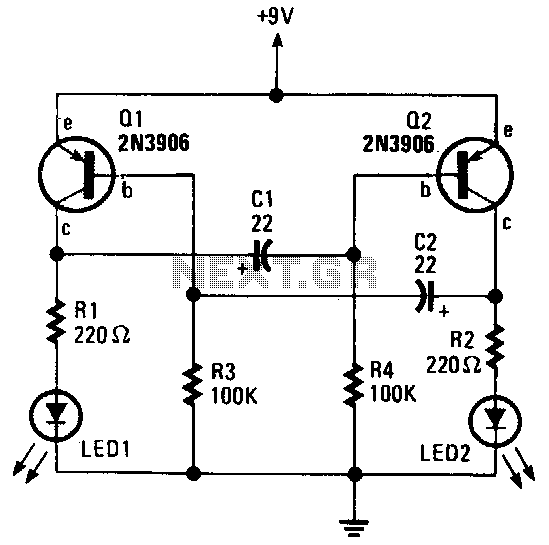
Alternating-led-flasher

The alternating LED flasher is a two-transistor oscillator with LEDs connected to the collector of each transistor, allowing them to light in sync with the circuit's oscillations.
The alternating LED flasher circuit utilizes a two-transistor oscillator configuration, which is a fundamental design in electronics for generating square wave signals. This circuit typically consists of two NPN transistors, resistors, and capacitors arranged in a feedback loop that enables oscillation.
In this design, the two transistors are connected in such a way that when one transistor is turned on, it causes the other to turn off and vice versa. This switching action generates a repetitive oscillation. The LEDs are connected to the collectors of the transistors, which means that as the transistors switch on and off, the LEDs will illuminate alternately.
To construct this circuit, the following components are required:
1. Two NPN transistors (e.g., 2N3904).
2. Two LEDs of desired colors.
3. Resistors to limit the current through the LEDs and to provide biasing for the transistors.
4. A capacitor to set the timing of the oscillation.
The circuit can be powered by a DC voltage source, typically between 5V to 12V, depending on the specifications of the components used. The value of the resistors and capacitors will determine the frequency of the oscillation, which can be calculated using the formula for an RC oscillator.
Overall, this alternating LED flasher circuit is a simple yet effective way to create visual signals and can be utilized in various applications, such as decorative lighting, indicators, or as a teaching tool for understanding basic oscillation principles in electronics.The alternating LED flasher is simply a twotransistor oscillator witb LEDs connected to tbe collector of each transistor, so that tbey light in time witb the circuit"s oscillations.
The alternating LED flasher circuit utilizes a two-transistor oscillator configuration, which is a fundamental design in electronics for generating square wave signals. This circuit typically consists of two NPN transistors, resistors, and capacitors arranged in a feedback loop that enables oscillation.
In this design, the two transistors are connected in such a way that when one transistor is turned on, it causes the other to turn off and vice versa. This switching action generates a repetitive oscillation. The LEDs are connected to the collectors of the transistors, which means that as the transistors switch on and off, the LEDs will illuminate alternately.
To construct this circuit, the following components are required:
1. Two NPN transistors (e.g., 2N3904).
2. Two LEDs of desired colors.
3. Resistors to limit the current through the LEDs and to provide biasing for the transistors.
4. A capacitor to set the timing of the oscillation.
The circuit can be powered by a DC voltage source, typically between 5V to 12V, depending on the specifications of the components used. The value of the resistors and capacitors will determine the frequency of the oscillation, which can be calculated using the formula for an RC oscillator.
Overall, this alternating LED flasher circuit is a simple yet effective way to create visual signals and can be utilized in various applications, such as decorative lighting, indicators, or as a teaching tool for understanding basic oscillation principles in electronics.The alternating LED flasher is simply a twotransistor oscillator witb LEDs connected to tbe collector of each transistor, so that tbey light in time witb the circuit"s oscillations.
